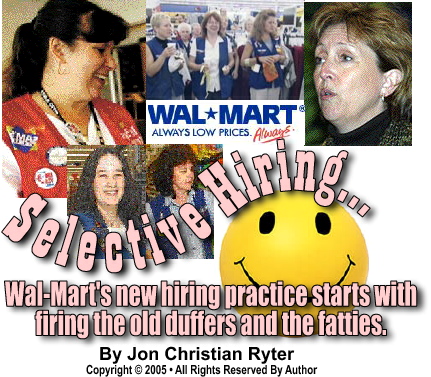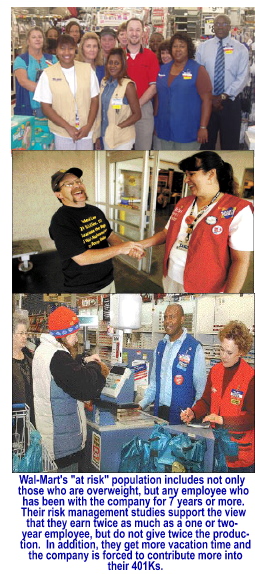
News
Behind the Headlines
Two-Cents Worth
Video of the Week
News Blurbs
Articles
Testimony
Bible Questions
Internet Articles (2015)
Internet Articles (2014)
Internet
Articles (2013)
Internet Articles (2012)
Internet Articles (2011)
Internet Articles (2010)
Internet Articles
(2009)
Internet Articles (2008)
Internet Articles (2007)
Internet Articles (2006)
Internet Articles (2005)
Internet Articles (2004)
Internet Articles (2003)
Internet Articles (2002)
Internet Articles (2001)


Wal-Mart
has decided, from a shareholder perspective, it can no longer
afford to hire the elderly, the slowly aging, or the obese. .jpg) In
a 27-page memo written to Wal-Mart's board of directors
by Susan Chambers, the company's Executive Vice President
of Risk Management, Chambers outlined the plan—and
the logic—for trimming (pardon the pun) obese workers from
the payroll and, at the same time, eliminating full time or permanent
part-time at-risk seniors who receive health benefits. Chambers
also recommended to the board that Wal-Mart discourage
mature, tenured employees from staying with the company by reducing
the size and frequency of raises and any other related cost of
living adjustments, and by scaling back on the amount of paid
vacation a Wal-Mart associate would receive after
7-years. What Wal-Mart executives hope this move
will do is cause longtime Wal-Mart associates—who
are now viewed as a financial drag on the bottom line—to
quit.
In
a 27-page memo written to Wal-Mart's board of directors
by Susan Chambers, the company's Executive Vice President
of Risk Management, Chambers outlined the plan—and
the logic—for trimming (pardon the pun) obese workers from
the payroll and, at the same time, eliminating full time or permanent
part-time at-risk seniors who receive health benefits. Chambers
also recommended to the board that Wal-Mart discourage
mature, tenured employees from staying with the company by reducing
the size and frequency of raises and any other related cost of
living adjustments, and by scaling back on the amount of paid
vacation a Wal-Mart associate would receive after
7-years. What Wal-Mart executives hope this move
will do is cause longtime Wal-Mart associates—who
are now viewed as a financial drag on the bottom line—to
quit.
Wal-Mart is addressing, the Chambers memo cites, the need for the company to "...fully address those challenges...[with]...five bold steps that will require more explicit trade-offs between cost, Associate satisfaction and public reputation." Chambers noted that Wal-Mart's most pressing issue was healthcare "...because well-funded, well-organized critics..." (such as the Teamsters Union and advocacy groups like Wal-mart Watch) "...as well as state government officials are shining a bright light on Wal-Mart's offering."
 Wal-Mart,
in what they thought was a secret 27-page risk assessment, suggested
that it might reduce healthcare costs by at least $1 billion per
year by excluding much of the company's aging employee population
from coverage by changing their employment status from full time
to temporary, by offering them severance packages to get them
to quit—or by simply finding an excuse to fire them.
Wal-Mart,
in what they thought was a secret 27-page risk assessment, suggested
that it might reduce healthcare costs by at least $1 billion per
year by excluding much of the company's aging employee population
from coverage by changing their employment status from full time
to temporary, by offering them severance packages to get them
to quit—or by simply finding an excuse to fire them.
To cut costs and increase shareholder profits Wal-mart will realign eligibility requirements by decreasing cross-subsidization of spouses and family members, and by lowering the amount of company-paid life insurance.
This will be done by not to providing healthcare to full time employees until they have worked 1,000 hours—about 6 months rather than the traditional 90 days—and excluding family coverage until the employee had worked 2,000 hours (roughly a year). Wal-Mart argued in the memo that by reducing the overall cost of healthcare—which now consumes 19% of sales—the company will actually be able to offer health insurance to more of its low-income currently ineligible part-time employees. Most of them, however, don't want the Wal-Mart benefits because [a] its too expensive and [b] it does not provide as much coverage as the taxpayer-funded Medicaid they currently receive because, at their income levels, they are still well below the poverty level. (So much for the myth that Wal-Mart employees are the highest paid in the retail industry.)
The long term strategy of Wal-Mart is to discourage mature citizens from applying for permanent full-time jobs in their stores. Most job applicants 45-years of age or older will find it hard to land a full-time job at Wal-mart in the future. The company appears to be increasingly focused on recruiting younger workers who are less likely to get sick and run up large medical bills. Wal-mart appears singularly focused on finding young people who aren't thinking about the future and who are less inclined to make career commitments to Wal-Mart—and equally unconcerned about getting Wal-Mart to make career commitments to them.
Most young people go to Wal-Mart for their "starter-job"—the way they used to go to McDonald's ten years ago. They're looking for a paycheck to finance their first new car that Mom and Dad don't co-own, and not much else. Except perhaps the guys are hoping to date the cute young chick behind the jewelry counter, and the sweet young things in the "smile" smock are fascinated with the good-lookin' hunk in automotive. The local Wal-Mart store is increasingly a place where you might see employees celebrating a baby shower or a bridal shower—but seldom a retirement lunch.
The
Chambers' memo contemplates changing a long-standing Sam
Walton policy of hiring any US war veteran who has seen military
action. The memo suggests that since veterans are more likely
than non-veterans to need medical attention—and that those
who are disabled will have a tougher time performing simple tasks
like cart-gathering or working as a cashier—stores will operate
more proficiently with younger, more agile employees.  Chambers'
musings about not hiring disabled war veterans or others with
disabilities—which were nothing more than talking points
for the company's board of directors to debate—would violate
the Americans With Disability Act. (I expect the Wal-Mart
board will reject that idea out-of-hand since the lawsuits and
lost customers Wal-Mart would face by discriminating
against disabled veterans would likely cost them far more than
the lower job performance of the disabled.)
Chambers'
musings about not hiring disabled war veterans or others with
disabilities—which were nothing more than talking points
for the company's board of directors to debate—would violate
the Americans With Disability Act. (I expect the Wal-Mart
board will reject that idea out-of-hand since the lawsuits and
lost customers Wal-Mart would face by discriminating
against disabled veterans would likely cost them far more than
the lower job performance of the disabled.)
The Chambers memo also addressed the newest workplace malady—obesity. Wal-Mart workers, many of whom are overweight, experience sicknesses at a rate greater than the national average because, as a general rule, Wal-mart is viewed as a bottom-feeder employer whose applicants generally come from the lowest income strata where poor eating habits and obesity are more prevalent. Obesity and its uniquely-related healthcare problems is driving the cost of healthcare and other workplace expenses through the roof as fast-food restaurants increasingly serve the American consumer as a substitute for the family kitchen. Obesity-related diseases like heart disease and diabetes are on the rise because most low income one- or two-income American families are simply too tired to prepare healthy meals after a hard day at work.
Because of higher retail prices and higher income taxes, it now takes two incomes to make ends meet in most households. Most heads-of-household can't afford to take off work to go to their primary care physician's office during working hours. They simply can't afford the lost wages. If they don't have flex time available where they work, they are forced to wait until the end of their shift when they can go to the hospital's emergency room since their doctor's office is generally closed in the evening. As a result, they pay two to three times as much for medical treatment, driving up the cost of the premiums and the co-pays they are obligated to pay.
That's why Wal-Mart is actually contemplating placing "emergicare" outpatient facilities in many of their stores. Wal-Mart employees and their families—as well as the general public—would find competent, low cost medical treatment there. Since the clinics would employ Wal-Mart doctors and nurses, the use of these facilities would actually reduce Wal-Mart's out-of-pocket expenses for its employees. Opening the clinics to the general population would create a new profit center for the company—and create a brand new economic enemy for Wal-Mart—the medical community.
In addition, Wal-Mart is contemplating developing its own HMO network to further cut costs and, they say, add more employees to the network. Out of 1.3 million employees, about 900 thousand are currently covered. Buried behind the bright light of public scrutiny will be some tradeoffs that will never be exposed to the light of day in the media. Among them are cuts Wal-Mart is already considering—reducing the amount to life insurance per associate to a ceiling of $12,000; charging employees twice as much for family additions to their policies. Very likely, overweight associates will either pay a higher premium for coverage, or some health risks due to obesity will be excluded until the overweight employee takes off the excess weight—providing overweight employees who are viewed as a health risk are not simply singled out and fired.
With 1.3 million employees, Wal-Mart is the largest employer in the United States and is one of the largest in the world. If Wal-Mart is allowed to engage in the covert practice of "selective hiring" and "economic firing" it will not be long before every retailer in America is doing the same. Affected will be both middle-aged and overweight workers. Wal-Mart's plan, according to Chamber's 27-page risk assessment proposal is to hire what Wal-Mart calls the "low utilizer." Low utilizers are young people who will cost Wal-Mart less money to employ. Less in annual healthcare costs and less in benefits and wages. Furthermore, since young people are stronger, more agile and they can lift more without fear of injury, hiring "low utilizers" translates into lower liability insurance premiums as well. For Wal-Mart's management, its a win-win situation. For Wal-Mart associates, job security will become a meaningless word since the "low utilizers" that are so desirable by Wal-Mart today will become tomorrow's deadwood when cost of living increases and merit raises price the aging workforce—that is no more productive than the new hires who are earning half as much—out of a job.

Copyright © 2009 Jon Christian Ryter.
All rights reserved.


